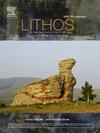Troilite nano-inclusions in apatite: Implications for melt immiscibility from a lamprophyric magma
IF 2.9
2区 地球科学
Q2 GEOCHEMISTRY & GEOPHYSICS
引用次数: 0
Abstract
Calcium phosphate apatite is a volatile-rich mineral ubiquitous in terrestrial and planetary igneous rocks and can form by a variety of processes. However, the utilization of this powerful mineral for unraveling complex magmatic systems is challenged due to its crystallographic complexity. Recent work has demonstrated that examination by transmission electron microscopy (TEM) can reveal nanostructures that are of paramount importance for a correct interpretation of its chemistry. Here, we have examined different apatite grains from two thin sections of Les Guilleries lamprophyre dykes (NE Spain), representing the last pulses of deep magma ascension at the end of the Variscan orogeny. We have identified two different generations of F-rich apatites (magmatic and hydrothermal), which have been examined by SEM, EPMA, TEM, and Raman spectroscopy. Primary, magmatic apatites are close to rounded and even-sized, whereas secondary, hydrothermal apatites are highly acicular, cut most of the mineral phases, and contain slightly higher amounts of Cl and detectable rare-earth elements compared to magmatic apatites. Transmission electron microscopy work shows that magmatic apatites contain abundant nano-inclusions (∼5–60 nm in size) in their cores, consisting of euhedral, negative crystals of troilite, an amorphous phase, and/or a possible gas phase. We argue that fluctuations of temperature during ascent of the lamprophyric magma triggered S saturation and subsequent unmixing of a Fe![]() S melt from the silicate magma. The immiscible Fe
S melt from the silicate magma. The immiscible Fe![]() S melt was trapped in negative crystals of rapidly growing apatite grains. During ascent of the magma, an additional fluctuation of temperature slowed its growth rate and prevented the generation of new, negative crystals, thus the rims of these apatite grains grew free of inclusions. Upon cooling, troilite crystallized at a temperature of ∼950 °C and relatively high oxygen and sulfur fugacities (log fS2 ≈ −7; log fO2 < −8.5). The crystallizing troilite was likely followed by exsolution of a Si,Cl-bearing aqueous fluid and a gas phase. Finally, some Cl (∼0.43 wt%) and Si (∼2.87 wt%) from the aqueous fluid phase within the inclusions migrated outwards and interacted with the host apatite at very localized scales (a few nanometers). This study suggests that the unmixing of Fe
S melt was trapped in negative crystals of rapidly growing apatite grains. During ascent of the magma, an additional fluctuation of temperature slowed its growth rate and prevented the generation of new, negative crystals, thus the rims of these apatite grains grew free of inclusions. Upon cooling, troilite crystallized at a temperature of ∼950 °C and relatively high oxygen and sulfur fugacities (log fS2 ≈ −7; log fO2 < −8.5). The crystallizing troilite was likely followed by exsolution of a Si,Cl-bearing aqueous fluid and a gas phase. Finally, some Cl (∼0.43 wt%) and Si (∼2.87 wt%) from the aqueous fluid phase within the inclusions migrated outwards and interacted with the host apatite at very localized scales (a few nanometers). This study suggests that the unmixing of Fe![]() S melts during calc-alkaline magmatism may be more common than previously recognized, which has important implications for potentially concentrate economically valuable elements that may lead to the formation of ore deposits.
S melts during calc-alkaline magmatism may be more common than previously recognized, which has important implications for potentially concentrate economically valuable elements that may lead to the formation of ore deposits.
求助全文
约1分钟内获得全文
求助全文
来源期刊

Lithos
地学-地球化学与地球物理
CiteScore
6.80
自引率
11.40%
发文量
286
审稿时长
3.5 months
期刊介绍:
Lithos publishes original research papers on the petrology, geochemistry and petrogenesis of igneous and metamorphic rocks. Papers on mineralogy/mineral physics related to petrology and petrogenetic problems are also welcomed.
 求助内容:
求助内容: 应助结果提醒方式:
应助结果提醒方式:


